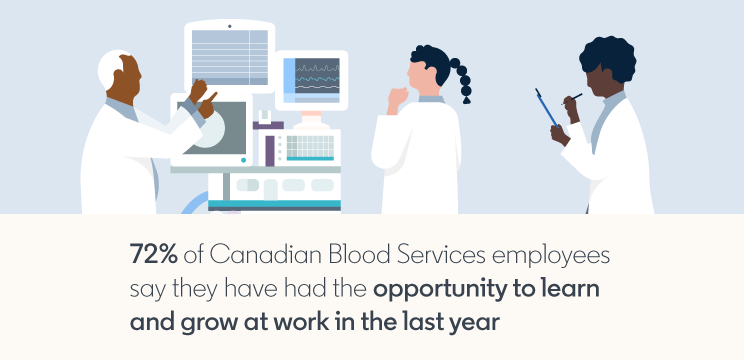
How This L&D Specialist Got Her Nonprofit to Embrace Learning Opportunities
Abigail St. John has worn many hats in her 16 years with Canadian Blood Services, a nonprofit organization that is nationally responsible for a secure system of life essentials for transfusion and transplantation that’s reliable, accessible, and sustainable. To do this, the nonprofit undertakes a broad range of activities in four main areas: blood, plasma, stem cells, and organs and tissues.
“I love the opportunity to work in an organization that not only supports all Canadians, but also provides so much opportunity for employees to grow and develop,” Abigail says.
In her current role as a Learning and Development (L&D) Specialist, Abigail is part of a team that supports Canadian Blood Services’ almost 4,000-strong workforce to get the most from the ongoing L&D opportunities that have benefited Abigail throughout her career.
“With so many different roles in the organization, there are always opportunities to move internally,” she explains, “and employees are encouraged to do so by their leaders. This helps to not only retain our talent, but also to build employees’ skills and knowledge, which can be shared across the organization.”
One of the opportunity areas that Abigail and the Employee and Leadership development team identified to help employees navigate their career journey was to better understand whether they wanted to move into a people leader role. The team implemented an Aspiring Leaders Program to expose employees to the world of leadership, allow them to build skills for present and future opportunities, and help them determine if people leadership is a career path they’d like to pursue.
They used LinkedIn Learning to make that happen.
Building a flexible learning & development program for a dynamic nonprofit
Canadian Blood Services faced a unique challenge in getting its entire organization to use learning programs. “Two-thirds of us work out on the frontline with donors or to support the production and distribution of life essentials,” Abigail says. “They’re not at desks working on personal computers, and they must focus on the critical task at hand. So, the challenge is, how do we allow time for these employees to develop their career beyond their day-to-day?”
To account for this, Canadian Blood Services turned to LinkedIn Learning to ensure both office and frontline employees could engage in L&D opportunities whenever and wherever they wanted.
“We wanted to make sure this opportunity was at everyone’s fingertips 24/7 and accessible through their own devices,” Abigail says. “We created QR codes people can just click to activate their license.”

The team also made sure that every employee could access any courses they were interested in. “Even though you may be taking a specific curated program, you can still learn more about other skills and opportunities,” Abigail says.
One unexpected result of this approach is that it allows employees to test whether the path they’re heading down is really the right one for them. If they realize it isn’t after taking a few courses, they can start discussing alternative options with their manager.
“We’ve had several learners say ‘I don’t want to be a people leader, but I thought that was my only route to progress. Now, I’m seeing other opportunities I wouldn’t have known about,’” Abigail says. “People are finding out there are other ways to advance their professional development than just becoming people leaders, thanks to the program. I think that’s one of the biggest wins we can take.”
Canadian Blood Services’ equitable, learner-driven approach to L&D has proven both highly effective and popular among employees.
“We found that 72% of our people say they’ve had the opportunity to learn and grow at work in the last year,” Abigail says. “Almost 66% of the organization has activated their learning licenses, and of that 66%, approximately 38% are frontline workers.”

For Abigail, one of the most encouraging signs of the program’s success is when and for how long team members are learning. “The number of learning hours and the time people are learning is all over the place,” she says. “People are picking this up whenever it’s convenient for them.”
Advice for other nonprofits: “This is a lifelong journey you can participate in”
Abigail and Canadian Blood Services have six major takeaways for any nonprofit that wants to drive L&D engagement across its organization:
Prioritize truly equitable access: “We opened LinkedIn Learning to everyone and provided equitable access, so anyone could develop the way they wanted to. This is helping us create a culture of continuous development.”
Give employees the freedom to learn what they want: “We provide content that not only helps people develop professionally, but gives them topics for personal development, like photography, too.”
Differentiate L&D from on-the-job training: “L&D at Canadian Blood Services is about developing a broader range of skills as opposed to role-specific training for an employee. It’s totally voluntary — jump in if you want, because the organization is providing access for you.”
Get the enthusiastic support of leadership: “One of the first things we did was get the sponsorship of our Vice President and our CEO. We had town halls where our CEO and executive management promoted the program.”
Partner with other teams across the organization: “We’ve also collaborated to launch new programs around diversity, equity, and inclusion (DEI) and wellness. This is providing resources to demonstrate how supporting your professional development supports psychological well-being. We aren’t acting in a silo — we’re aligning with other teams to systemically support our employees throughout their careers and show that learning and development is a lifelong journey you can participate in.”
Provide ongoing support: “We worked with our [internal IT] support desk to make sure they understood what kind of help to give learners. It’s working beautifully. They rarely get calls now because we guide learners to LinkedIn Learning support, and from there they get everything they need.”
To learn how LinkedIn Learning could help your nonprofit create an L&D program that engages your entire workforce, reach out today.

